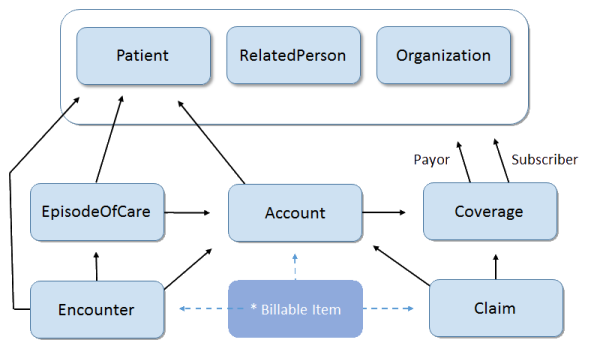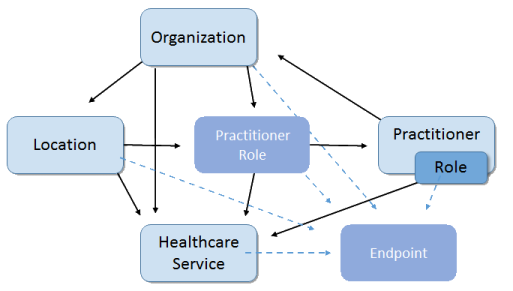This page is part of the FHIR Specification (v1.6.0: STU 3 Ballot 4). The current version which supercedes this version is 5.0.0. For a full list of available versions, see the Directory of published versions  . Page versions: R5 R4B R4 R3
. Page versions: R5 R4B R4 R3


The Administrative module covers the base data that is then linked into
the other modules for clinical content, finance/billing, workflow, etc.
This of course is built on the FHIR technology platform modules.
Before any clinical data can be recorded, the basic information on the patient must be recorded, and then often the basis of the interaction (such as an encounter)

| Patient Registers | ||
|---|---|---|
| Track people involved in receiving healthcare, the basics nearly everything else references back to | ||
| Name | Aliases | Description |
| Patient | SubjectOfCare Client Resident | Demographics and other administrative information about an individual or animal receiving care or other health-related services. |
| RelatedPerson | Information about a person that is involved in the care for a patient, but who is not the target of healthcare, nor has a formal responsibility in the care process. | |
| Person | Demographics and administrative information about a person independent of a specific health-related context. | |
| Group | Represents a defined collection of entities that may be discussed or acted upon collectively but which are not expected to act collectively and are not formally or legally recognized; i.e. a collection of entities that isn't an Organization. | |

Note: Patient linking should also be considered when evaluating searches with references to other resources. e.g. Searching for conditions for a patient.
At present the specification does not define if the links should be also followed to include conditions that reference the linked patients too. We are currently seeking feedback on this.
Note: The Person resource may be used as a centralized register of people that may eventually be involved in healthcare, and could be used as the central coe demographics register.
However the fields/values in Person are duplicated in the other resources, and in many cases the Person resource will be hosted on external systems.
| Clinical Categorization Resources | ||
|---|---|---|
| Most clinical actitivies occur grouped in some way. Long term care is typically covered by an EpisodeOfCare, where short term care by encounters. Account associates the tracking of transactions back to a Patient (or other resource). Flag is just used to highlight a warning or other notification about a patient (or other resource) | ||
| Name | Aliases | Description |
| EpisodeOfCare | Case Program Problem | An association between a patient and an organization / healthcare provider(s) during which time encounters may occur. The managing organization assumes a level of responsibility for the patient during this time. |
| Encounter | Visit | An interaction between a patient and healthcare provider(s) for the purpose of providing healthcare service(s) or assessing the health status of a patient. |
| Account | Cost center | A financial tool for tracking value accrued for a particular purpose. In the healthcare field, used to track charges for a patient, cost centres, etc. |
| Flag | Barriers to Care, Alert | Prospective warnings of potential issues when providing care to the patient. |

Note: The Billable Item resource does not exist at the moment, but is proposed to be the link between the encounters and the billing/climing systems.
| Service Provider Directory Resources | ||
|---|---|---|
| Service Directory resources are usually stored in the administration section of applications, and may even be synchronized from external systems. | ||
| Name | Aliases | Description |
| Organization | A formally or informally recognized grouping of people or organizations formed for the purpose of achieving some form of collective action. Includes companies, institutions, corporations, departments, community groups, healthcare practice groups, etc. | |
| Location | Details and position information for a physical place where services are provided and resources and participants may be stored, found, contained or accommodated. | |
| Practitioner | A person who is directly or indirectly involved in the provisioning of healthcare. | |
| HealthcareService | The details of a healthcare service available at a location. | |
| Endpoint | The technical details of an endpoint that can be used for electronic services, such as for web services providing XDS.b or a REST endpoint for another FHIR server. This may include any security context information. | |
| PractitionerRole | A specific set of Roles/Locations/specialties/services that a practitioner may perform at an organization for a period of time. | |

Note: The PractitionerRole resource is a draft concept to experiment with the extraction from within the practitioner resource. It will be the subject of a Provider Directory Connectathon, and the Baltimore WGM Connectathon in September 2016
If this is approved, then the Role component in Practitioner would likely be removed.
| Devices and Substances | ||
|---|---|---|
| Other assets are often registered in the administration system, and maintained as master files. | ||
| Name | Aliases | Description |
| Device | This resource identifies an instance or a type of a manufactured item that is used in the provision of healthcare without being substantially changed through that activity. The device may be a medical or non-medical device. Medical devices includes durable (reusable) medical equipment, implantable devices, as well as disposable equipment used for diagnostic, treatment, and research for healthcare and public health. Non-medical devices may include items such as a machine, cellphone, computer, application, etc. | |
| DeviceComponent | Describes the characteristics, operational status and capabilities of a medical-related component of a medical device. | |
| DeviceMetric | Describes a measurement, calculation or setting capability of a medical device. | |
| Substance | A homogeneous material with a definite composition. | |

Patient privacy is handled with security labels and tags in the Resource Meta property. This is the standard way that the FHIR specification provides this supporting information to a sub-system that implements it (which is not defined by FHIR).
One of the more common use cases is for marking a patient as being a celebrity.
For more general considerations, see the Security and Privacy module.

All systems require access to administrative resources, such as for:

The Patient Administration is currently working through resources that support:
Many of the administrative resources are part of the core resources that most systems
use first and have formed the basis for most people's first experiences with FHIR.
However this limitted exposure has still to be proven in all contexts, such as veterinary.